What Should Be Painted First, The Trim Or Body Of The Exterior Of The House
1 / 11
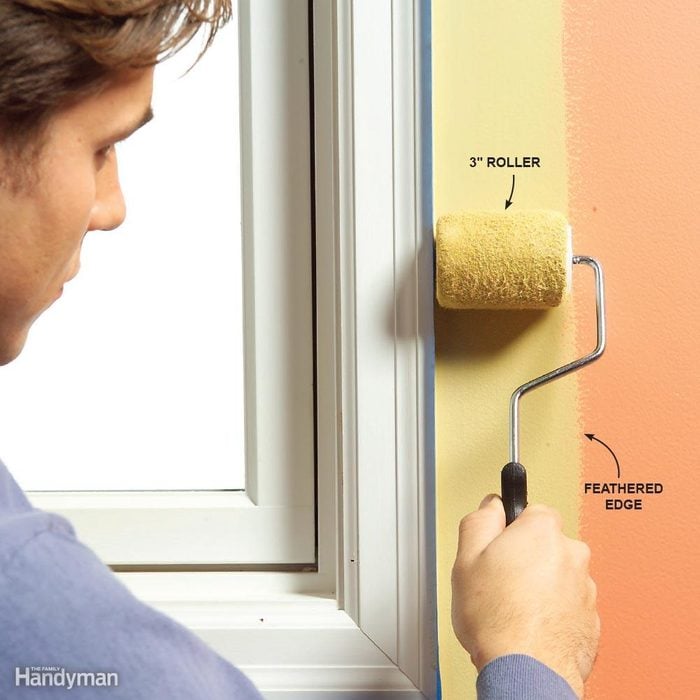
Gyre Paint Along the Edges for Consistent Texture
When it comes to wall painting, corners and areas adjacent to trim that are painted just with a brush have a noticeably different texture than the surrounding paint. To ensure the finished texture volition be consequent in these areas, brush on the door and trim paint, and then immediately roll it out before the pigment dries. Use a 3-in. roller with a nap that's the same thickness that was used for the rest of the wall painting. Gyre as close as you tin can without bumping the opposite wall or slopping paint onto the trim. Terminate brushing on the paint and rolling it out in ane expanse before moving on to the next section. Next, bank check out these 29 painting tool hacks to make your painting projects a breeze.
2 / eleven
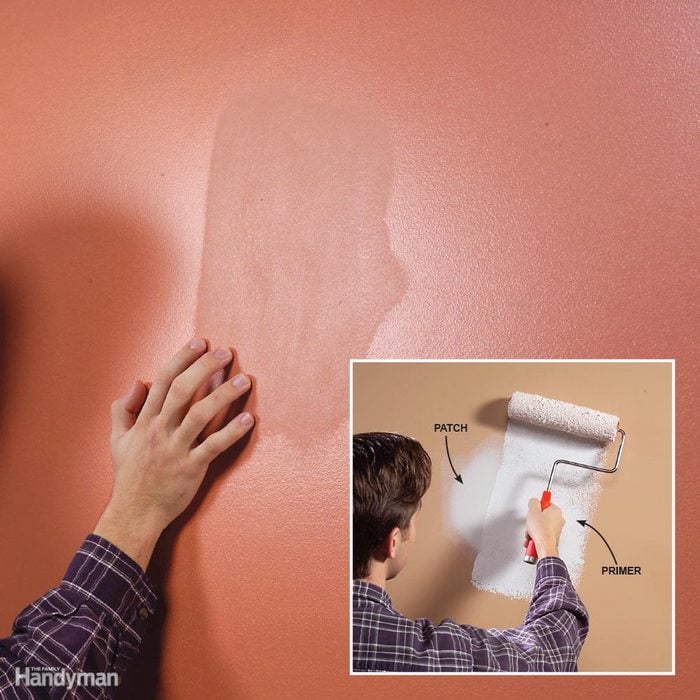
Prime and Texture Wall Patches to Avoid a Blotchy Finish
A common problem with wall painting is that freshly painted walls frequently wait blotchy. The color is uniform, merely the sheen isn't consistent. This commonly occurs over the holes and cracks you patched with a filler or drywall compound. The porous fillers absorb the paint, dulling the surface (a problem called 'flashing'). When light hits these dull spots, they stick out similar a sore thumb. The smooth patch also stands out in contrast to the slightly bumpy texture of the rest of the wall. A quick coat of primer is all it takes to eliminate flashing and texture differences when wall painting. Primer seals the patch then pigment won't sink in and look dull. To match texture, prime with a roller, feathering out the edges. Choose a nap thickness to match the surrounding wall texture (a 3/8-in. nap roller for smooth walls; ane/ii-in. for textured). Plus: Run across the game-changing painting tools our editors dear.
3 / 11
Try this trick to keep your paintbrushes fresh while yous have a break:
four / eleven
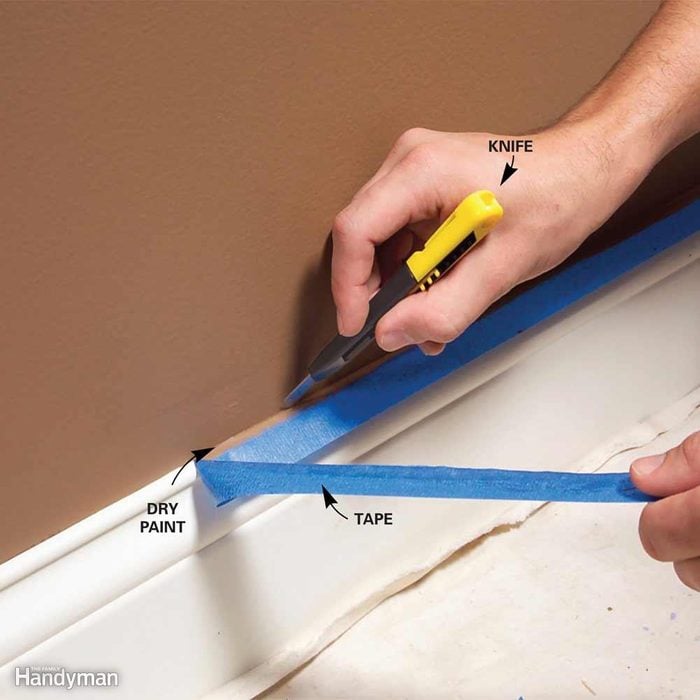
Permit Paint Dry, Then Cutting the Record Loose for a Perfect Border
Once paint is dry, you can't but pull the tape off the trim. Pigment forms a moving-picture show between the wall and the record, and removing the tape tears pieces of dried paint off the wall. And so before pulling off the record, cut it loose.
Wait for the paint to completely dry at least 24 hours, then use a sharp utility knife or box cutter knife to slice through the picture show. Starting time in an inconspicuous area to make sure the paint is difficult enough to slice cleanly. If you cut the paint while information technology's yet viscous, you'll make a mess. Every bit you cut the paint, pull upward the record at a 45-degree angle. Get more secrets of professional person painters.
five / 11
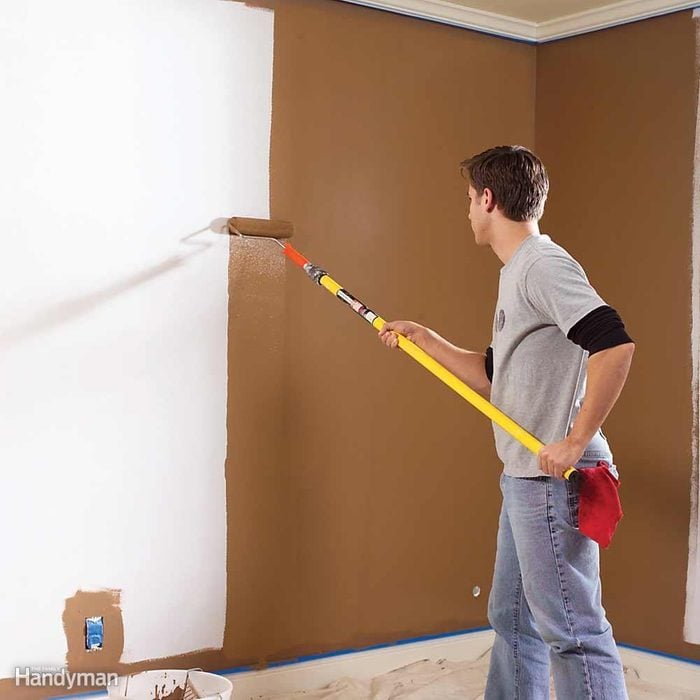
To Avoid Lap Marks when Wall Painting
To avert lap marks, coil the full peak of the wall and keep a wet edge. Lap marks are those ugly stripes caused by uneven layers of paint buildup, a common problem when wall painting. They occur when you curlicue over paint that's already partly dry. (In warm, dry out atmospheric condition, latex paint tin begin to stiffen in less than a infinitesimal!) The key to avoiding lap marks is to maintain a 'wet edge,' and so each stroke of your roller overlaps the previous stroke before the paint can begin to dry. To maintain a wet edge, paint an entire wall all at once. Outset at 1 end, running the roller up and down the total height of the wall, moving over slightly with each stroke. Move backward where necessary to fifty-fifty out thick spots or runs. Don't let the roller get nearly dry; reload it oft so that it's always at least half loaded. Keep the open side of the roller frame facing the expanse that'due south already painted. That puts less pressure on the open up side of the roller, so you're less likely to leave pigment ridges. Looking to paint your doors next, these are the tips you lot need to know.
6 / 11

Feather Out the Paint Where You Can't Go on a Wet Edge
You can't encompass large areas like ceilings, extra-tall walls or stairwells in single, continuous strokes, so the best fashion to minimize lap marks on these areas is to plumage out the paint along the edges that you can't go along wet. The thinner, feathered coat of paint will avoid the buildup that causes the lap mark.
To paint a large section without leaving lap marks, roll the nigh dry out roller in different directions forth the dry edge, feathering out the paint as you go. After completing the entire length of the wall or ceiling, move to the next section and paint over the feathered edges. For the second glaze, apply the paint in the opposite management. This crisscrossing pigment application sharply reduces (if not eliminates) lap marks.
seven / 11
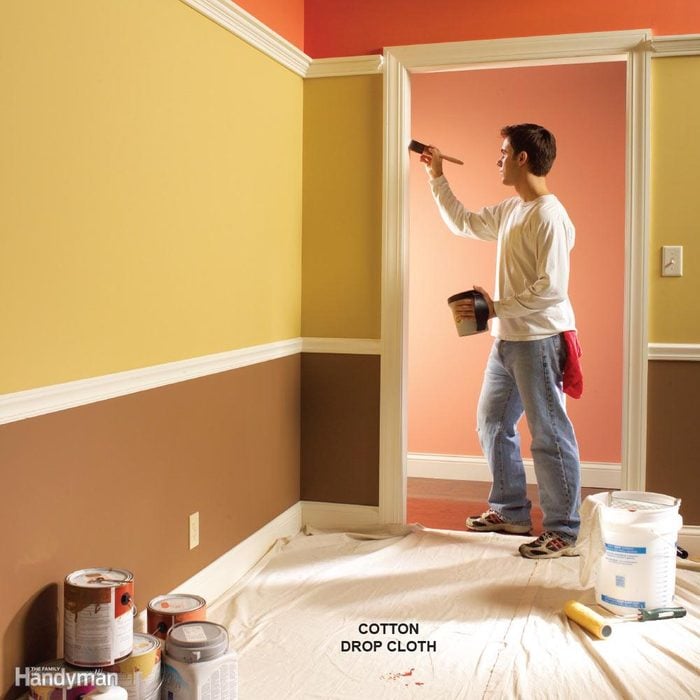
Utilize Cotton Drop Cloths Rather Than Plastic
When wall painting and trim painting, spills and spatters happen, regardless of how careful y'all are. It'south a lot easier to prepare for them than to wipe them out of your carpet or off your forest flooring after. All it takes is canvas drop cloths in your work expanse. The thick canvas stays in place, so yous don't need to tape it, and yous tin can use it to cover any surface. Plastic drib cloths are slippery to walk on or set a ladder on and don't stay in place. Fifty-fifty worse, pigment spills on plastic stay wet, and they tin can end up on your shoes and get tracked through the house. Canvass is glace on hard floors, so rosin paper is ameliorate over vinyl, tile and hardwood. Record the sheets together and to the floor to provide a nonslip surface. But even with canvas or rosin-paper driblet cloths, large spills nevertheless demand to get wiped up correct away or they'll seep through. Make clean spills with paper towels or cloth rags. Likewise, if you lot splatter paint on any other surface, wipe it upward immediately.
8 / 11
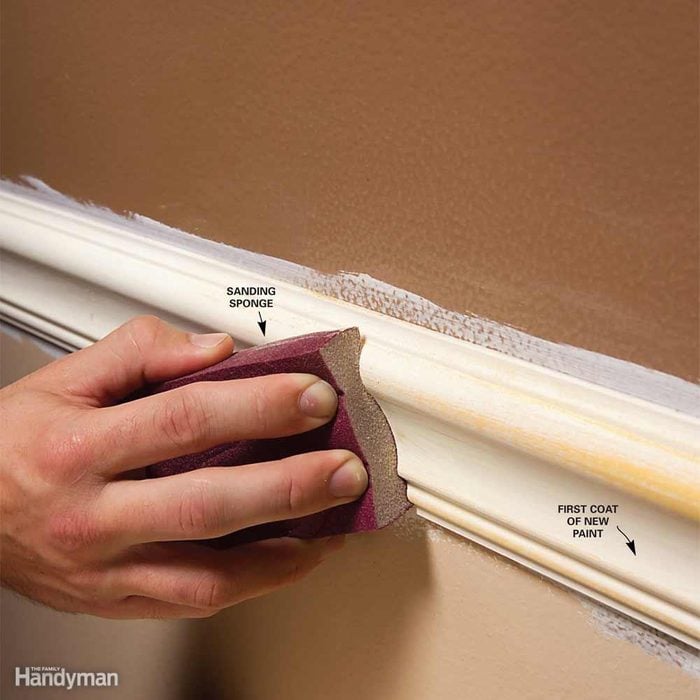
Sand Trim Between Coats for an Ultra-Smooth Finish
One coat of paint usually won't hide the underlying color and sheen on trim. And if you don't sand the surface smooth between coats, the stop may have a grainy texture. For a smooth terminate, sand the trim earlier applying each glaze of paint.Sand the trim with a fine-grit sanding sponge. Sponges get into crevices where sandpaper tin't get and utilise fifty-fifty pressure level. Then apply the first coat of paint, permit it dry out at least 24 hours, lightly sand it again for a completely polish surface, and apply the 2nd coat. Later each sanding, vacuum the trim, and so wipe it down with a tack cloth to remove the dust. Plus: If you spill paint, hither'southward how to remove paint from clothes.
9 / 11
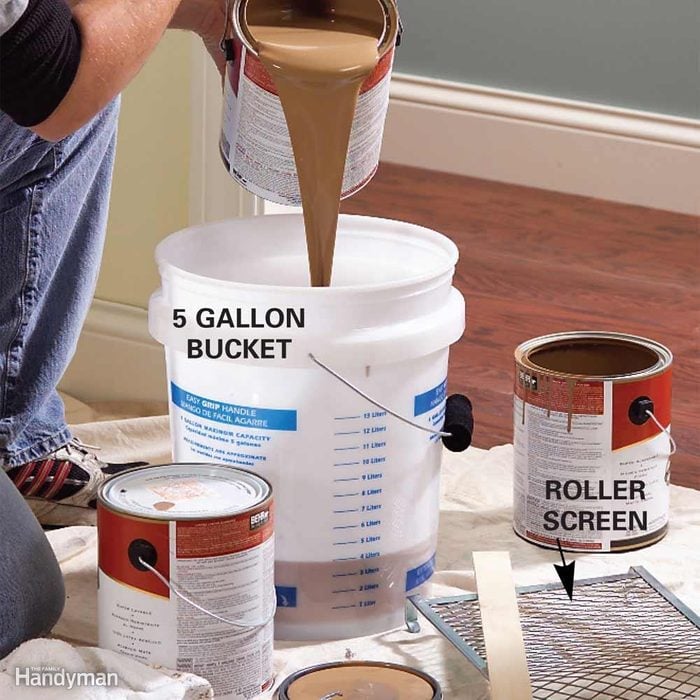
Mix Several Cans of Paint in a Large Saucepan for Consistent Color
Paint color may vary slightly from one can to the next. (Plus: here'southward the right way to test paint colors.) If yous take to open a new tin in the middle of a wall, the difference may be noticeable. Mixing the paints together eliminates the problem. It's best to gauge the amount of paint you'll need and mix it in a five-gallon bucket (a procedure chosen 'boxing'). When wall painting coverage is difficult to estimate, add more rather than less. You can always pour the leftover back into cans. For large wall painting jobs, use the bucket and a roller screen rather than a roller tray. It'southward much faster to load your roller with the screen than to utilise a roller pan. Only dunk it into the pigment bucket, so coil it along the screen until it stops dripping. Next, check out our favorite 5 gallon saucepan hacks.
ten / 11

Clean Muddied Surfaces So the Paint Can Form a Potent Bond
Paint dirty, oily surfaces and the paint will hands chip or peel off. Then earlier wall painting, make clean grimy areas with a deglosser or heavy-duty cleaner intended for prepaint cleaning. They work well to make clean painted, varnished or enameled surfaces to improve the adhesion of the new paint. They're ideal for cleaning greasy or oily areas like kitchen and bathroom walls and removing manus marks around light switches and doorknobs. Wipe on the cleaner in a circular motion using a lint-free fabric or annoying pad. Start at the bottom and work upwardly. After the surface is clean, fill in any nicks and holes, then sand them smooth before painting walls. The cleaners are bachelor at pigment stores, dwelling centers and on Amazon. Exist certain to vesture rubber gloves and center protection. Here are more tips for prepping walls before painting.
11 / 11
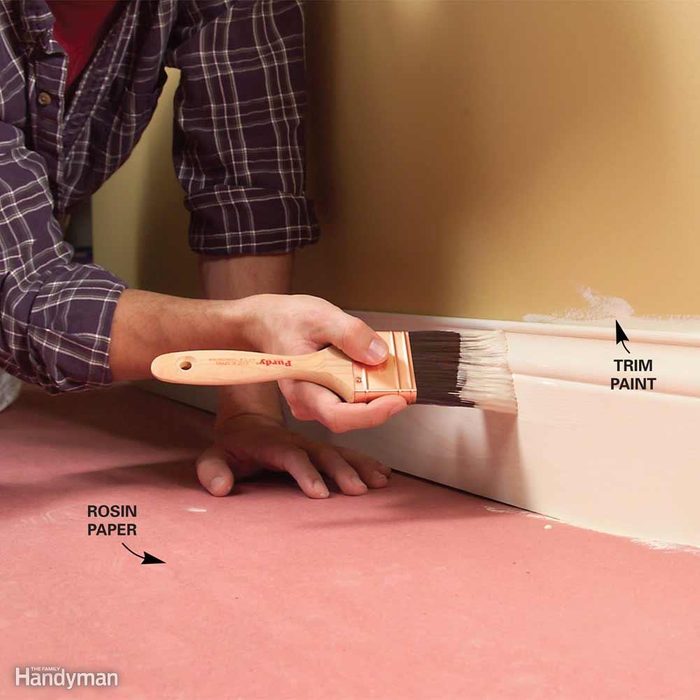
Paint the Trim Beginning, And then the Ceilings and Walls
Finally, the reply we've all been waiting for! Pros usually follow a certain club when painting a room. They paint the trim first, so the ceiling, then the walls. That's considering it'south easier (and faster) to record off the trim than to record off the walls. And you certainly don't want to record them both off! When painting the trim, you don't accept to be nifty. Merely concentrate on getting a smooth finish on the wood. Don't worry if the door and trim pigment gets slopped onto the walls. Yous'll cover information technology later on when painting walls. Once the trim is completely painted and dry (at least 24 hours), tape it off (using an 'easy release' painter's tape), so paint the ceiling, then continue on to wall painting.
Every product is independently selected past our editors. If you buy something through our links, we may earn an affiliate commission.
Originally Published: November 15, 2019
Source: https://www.familyhandyman.com/list/10-tips-for-a-perfect-paint-job/
Posted by: hallvint1982.blogspot.com


0 Response to "What Should Be Painted First, The Trim Or Body Of The Exterior Of The House"
Post a Comment